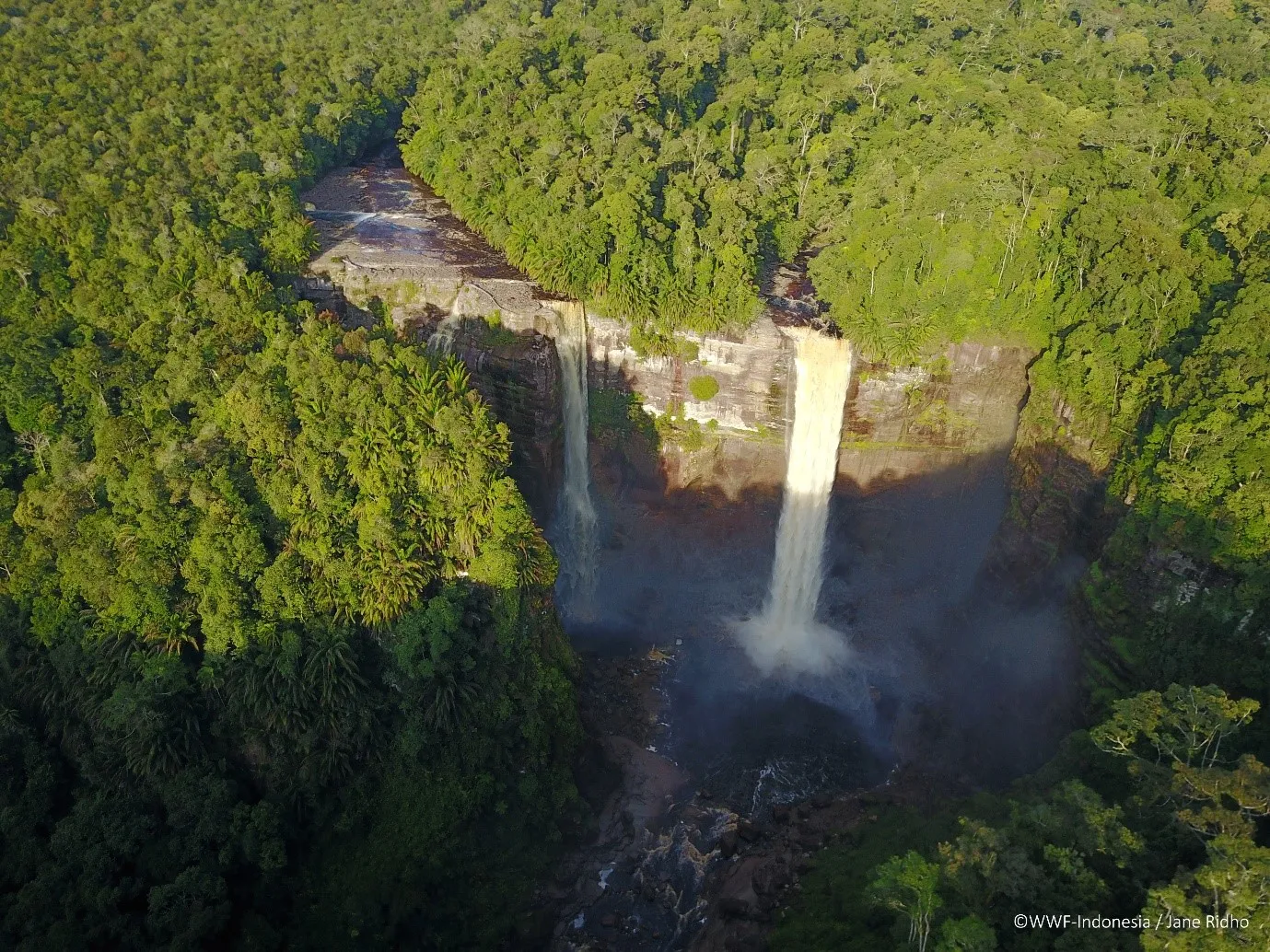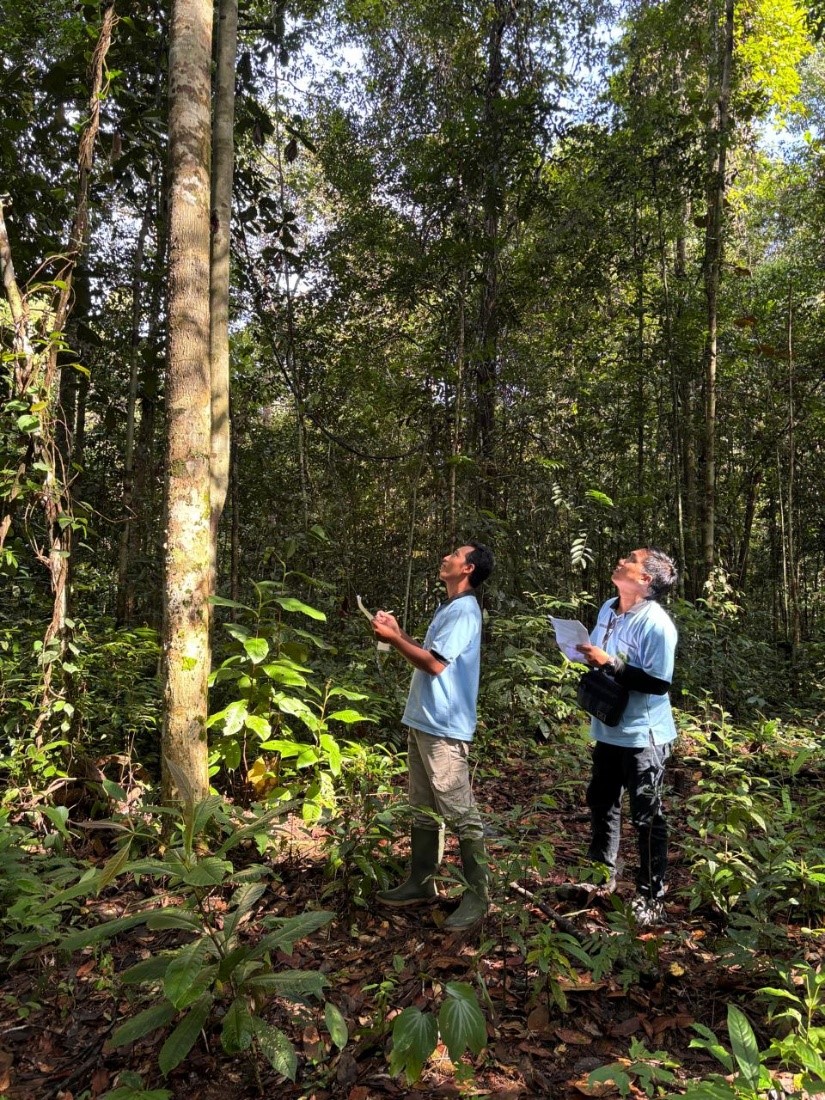
Musim Mas and HCV Network Pilot Farmer-Friendly High Conservation Value Tool in West Kalimantan
A New Approach to Conservation in Smallholder Landscapes
Musim Mas Group, in collaboration with the High Conservation Value (HCV) Network, has completed a pilot of the Nature Positive Farming (NPF) approach in the villages of Sungai Deden and Bukit Mulya in Sambas District, West Kalimantan, Indonesia.
The focus of the trial was to test and refine the NPF methodology — the first HCV-related tool designed for smallholders to use independently — and to explore how farmers could apply the assessment process themselves. By engaging local trainers and community members, the pilot aimed to bring an understanding of the importance of High Conservation Values directly to independent smallholder farmers, helping them recognise environmental risks, plan precautionary measures, and integrate conservation into their everyday farming practices. Independent smallholders are self-managed farmers not tied to any company. In Indonesia’s palm oil sector, their plots average around two hectares. It will help them identify environmental risks, plan precautionary measures, and monitor progress without the high costs of conventional assessments. The pilot engaged 15 trainers, including Musim Mas field staff, farmer representatives, and NGO partners.
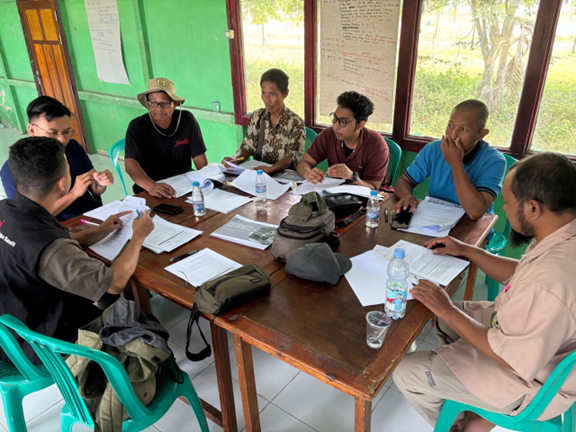
Building on a Long History of HCV Protection
Musim Mas has been addressing High Conservation Values for over a decade. Beginning in 2007, the Group has conducted HCV assessments in its plantations. In addition we have required suppliers to avoid developing on HCV areas, and integrated HCV management into its Independent Smallholder Program. These measures have conserved ecologically important areas such as forests, riparian zones, and habitats for rare and endangered species. The NPF pilot builds on this foundation, making HCV protection more practical, accessible, and farmer-led in independent smallholder settings.
Why This HCV Tool Matters
Conventional HCV assessments can be costly and complex for smallholders, creating a risk that those unable to meet buyer or certification requirements lose market access while resulting in the potential loss of ecologically important areas. The NPF approach offers a low-barrier entry point for conservation in smallholder landscapes, providing early signals of environmental risks so that if an area is deemed to be of high-risk, a smallholder can choose to consider other areas of their oil palm plots. By equipping farmers with easy-to-use tools, the approach helps protect biodiversity and ecosystem services while supporting livelihoods.
How the Nature Positive Farming Pilot Worked
1. Scoping (April 2025)
Musim Mas field staff and HCV Network Secretariat technical staff assessed the two villages’ readiness, mapped potential environmental features, and spoke with community leaders to align conservation goals with local priorities. Both villages, already certified to the Roundtable on Sustainable Palm Oil (RSPO) Independent Smallholder Standard, demonstrated through targeted interviews and dialogues, strong land governance and community cohesion — ideal conditions for testing the tool. While it was found that farmers are more motivated if there’s a clear link between conservation and livelihood benefits, it also emerged that ecological data is scarce so participatory mapping is important.
2. Train-the-Trainer (May 2025)
A three-day programme facilitated by HCV Network brought together 15 participants, including eight farmer leaders, Musim Mas field staff, and representatives from Solidaridad and SPKS. The training covered HCV and Nature Positive Farming concepts, farmer engagement techniques, and discussing how NPF could support RSPO audits which are needed for certification. Participants also trialled the Forest Integrity Assessment Tool (FIAT) for monitoring forest health and adapted the questionnaire to fit local contexts. Participants from each village further localised the outreach plans for their areas, prioritizing farmers in high-risk areas.
3. Deployment
Trained facilitators engaged 24 additional farmers through farm visits and small group discussions. Using the NPF questionnaire, they identified water resource management as the top conservation priority, with several farms located near rivers or drainage channels but the farmers had limited awareness of the need for buffer zones around water bodies. Other findings showed minimal environmental and social risks: no steep slopes, peat, or swamp areas; no Indigenous or customary land conflicts; and well-governed communal land arrangements overseen by the village government. All farmers reported clear land tenure, with no farms adjacent to classified forests. There was no evidence of wildlife conflict or exploitation, and cultural sites such as community cemeteries were well respected and did not affect land use.
4. Community Feedback
Farmers, facilitators, and project partners met to review the process and share suggestions. Participants appreciated the farmer-led approach and its relevance to daily farming. Recommendations included simplifying technical terms, using more local examples, and providing further practice to strengthen facilitation skills. Farmer facilitators lacked confidence in delivering questions naturally. Role-playing and more practice sessions in future trainings could help strengthen facilitation and communication skills.

Protecting High Conservation Value Areas “By Farmers, For Farmers”
The pilot confirmed that NPF can be implemented “by farmers, for farmers” as a practical complement to certification schemes. Interest has already extended beyond the pilot area, with Solidaridad and SPKS expressing intent to trial the approach elsewhere. Next steps include refining the tools, producing field guides with locally adapted examples, expanding to villages with more complex land use dynamics, and exploring integration into RSPO Independent Smallholder audits and village development planning.
“Musim Mas has for many years worked to identify and protect High Conservation Values in our operations and for many years. We have gone beyond to train smallholders even though they are not directly in our supply chain. This pilot takes that commitment a step further by putting practical tools directly into the hands of smallholders, empowering them to recognise and manage environmental risks on their own plots. By making conservation more accessible, we’re helping protect vital ecosystems while safeguarding market access and livelihoods,” said Rob Nicholls, General Manager of Programs and Projects with the Musim Mas Group.
Olivia Scholtz, Director of Implementation of the HCV Network, said that “This Nature Positive Farming pilot underscores that conservation is most accessible for smallholders where this generates livelihood benefits. This ‘by farmers, for farmers’ approach is a powerful complement to certification, and an important step towards scaling conservation outcomes across smallholder landscapes.”
If you are interested in the Nature Positive Farming tool, and could be interested in supporting other deployments or further development of the tool, please reach out to Olivia.
Related Posts
Musim Mas and HCV Network Pilot Farmer-Friendly High Conservation Value Tool in West Kalimantan
A New Approach to Conservation in Smallholder Landscapes
Read MoreCollaborative Conservation: How Sintang is Building a Sustainable Future
This blog explores how the Sintang District, together with WWF Indonesia, compiled and used landscape data on High Conservation Value (HCV) and High Carbon Stock (HCS) to guide planning and promote joint management for balanced growth and environmental and social protection.
Read MorePiloting Nature Positive Farming with smallholder producers in Indonesia
Last year, Nature Positive Farming programme was first piloted in an oil palm production landscape in Indonesia, within the Siak Pelalawan Landscape Programme (SPLP).
Read MoreOur Partnerships
Alongside many global initiatives, our work with partners promotes practices that help meet the global Sustainable Development Goalsand build a greener, fairer, better world by 2030.


Femexpalma
In April 2022, FEMEXPALMA and the HCV Network signed a 5-year cooperation agreement to promote sustainable production of palm oil in Mexico. FEMEXPALMA is a Mexican independent entity that represents palm production at the national level and promotes the increase of productivity in a sustainable way.
With global markets becoming stricter, for Mexican producers to be able to export to key markets such as the European Union, they must meet strict requirements such as certification by the Roundtable on Sustainable Palm Oil (RSPO). To be certified by RSPO, the HCV Approach must be applied prior to the establishment of any new oil palm plantations. With this cooperation agreement, the HCV Network will support FEMEXPALMA’s members and allies to design better strategies to identify, manage and monitor High Conservation Values and support smallholders to achieve RSPO certification and implement good agricultural practices.
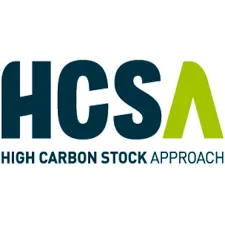

High Carbon Stock Approach
The High Carbon Stock Approach (HCSA) is an integrated conservation land use planning tool to distinguish forest areas in the humid tropics for conservation, while ensuring local peoples’ rights and livelihoods are respected.
In September 2020, HCV Network and the HCSA Steering Group signed a five-year Memorandum of Understanding (MoU) to strengthen their collaboration to conserve forests and uphold community rights in tropical forests. The HCS and HCV Approaches are cornerstones of corporate no deforestation and conservation commitments, and increasingly for actors working at different scales. The collaboration aims to further support effective implementation of these commitments through increased uptake of the HCV and HCS tools.
Through this MoU, HCSA and HCVRN are pursuing two main strategic goals:
- Strive to promote the application of the two approaches in tropical moist forest landscapes and explore further opportunities for collaboration.
- Ensure that, where the two approaches are applied together, this happens in a coordinated, robust, credible, and efficient manner, so that HCS forests and HCVs are conserved, and local peoples’ rights are respected.


World Benchmarking Alliance
From May 2022, the HCV Network is an ally at the World Benchmarking Alliance (WBA). WBA is building a diverse and inclusive movement of global actors committed to using benchmarks to incentivise, measure, and monitor corporate performance on the SDGs, and will assess and rank the performance of 2,000 of the world’s most influential companies against seven systems of transformation by 2023.
The scope of WBA’s circular transformation was expanded to cover nature and biodiversity as recognition of the need for greater understanding, transparency and accountability of business impact on our environment. The WBA Nature Benchmark was launched in April 2022, which will be used to rank keystone companies on their efforts to protect our environment and its biodiversity. As HCV Areas are recognised as key areas important for biodiversity, companies that publicly disclose their actions to identify and protect HCVs will contribute to the assessment of their performance against the benchmark.
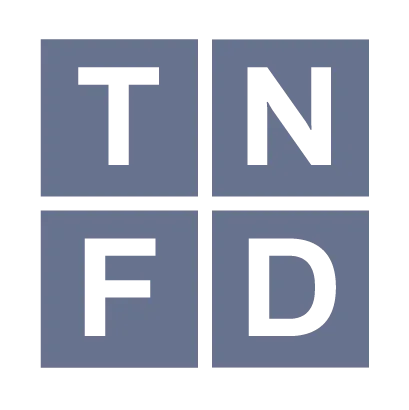

Taskforce on Nature-related Financial Disclosures - TNFD
The Taskforce on Nature-related Financial Disclosures (TNFD) is a global, market-led initiative, established with the mission to develop and deliver a risk management and disclosure framework for organizations to report and act on evolving nature-related risks, with the aim of supporting a shift in global financial flows away from nature-negative outcomes and toward nature-positive outcomes.
In April 2022, the HCV Network joined the TNFD Forum. The TNFD Forum, composed of over 400 members, is a world-wide and multi-disciplinary consultative network of institutional supporters who share the vision and mission of the task force.
By participating in the Forum, the HCV Network contributes to the work and mission of the taskforce and help co-create the TNFD Framework which aims to provide recommendations and advice on nature-related risks and opportunities relevant to a wide range of market participants, including investors, analysts, corporate executives and boards, regulators, stock exchanges and accounting firms.


Aquaculture Stewardship Council
The Aquaculture Stewardship Council (ASC) is the world’s leading certification scheme for farmed seafood – known as aquaculture – and the ASC label only appears on food from farms that have been independently assessed and certified as being environmentally and socially responsible. In 2021, the HCV Network and ASC formalised their collaboration through a Memorandum of Understanding (MoU). The MoU represents the first step in a fruitful relationship aimed at conserving HCVs in aquaculture. Although, existing guidance on the use of the HCV Approach currently focuses mainly on forestry and agriculture, the HCV Approach is however generic, and in principle also applicable to aquatic production systems. Through this MoU, this is recognised by the Aquaculture Stewardship Council (ASC) in their ASC farm standard, in which the protection of HCV areas is mentioned in the context of expansion
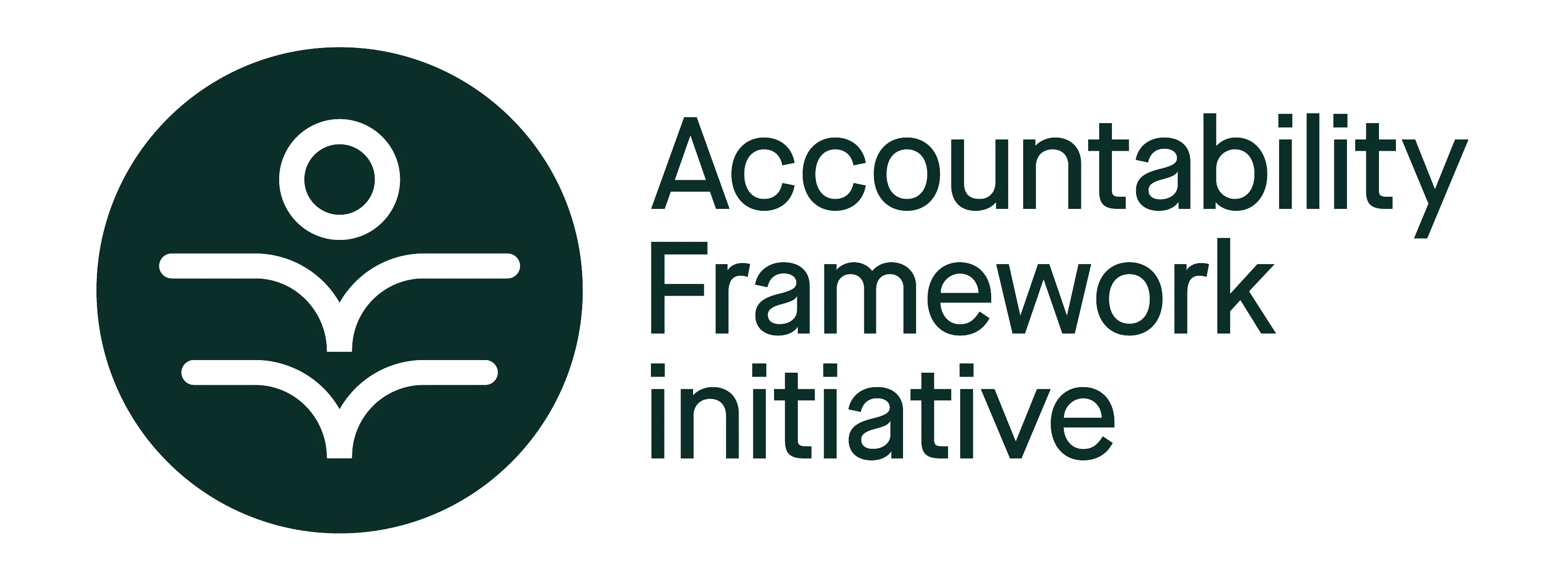

Accountability Framework Initiative
The Accountability Framework initiative (AFi) is a collaborative effort to build and scale up ethical supply chains for agricultural and forestry products. Led by a diverse global coalition of environmental and human rights organizations, the AFi works to create a “new normal” where commodity production and trade are fully protective of natural ecosystems and human rights. To pursue this goal, the coalition supports companies and other stakeholders in setting strong supply chain goals, taking effective action, and tracking progress to create clear accountability and incentivize rapid improvement. In July 2022, the HCV Network joined AFi as a Supporting Partner. AFi Supporting Partners extend the reach and positive impact of the AFi by promoting use of the Accountability Framework by companies, industry groups, financial institutions, governments, and other sustainability initiatives, both globally and in commodity-producing countries.


Biodiversity Credit Alliance
The Biodiversity Credit Alliance (BCA) is a global multi-disciplinary advisory group formed in late 2022. Its mission is to bring clarity and guidance on the formulation of a credible and scalable biodiversity credit market under global biodiversity credit principles. Under these principles, the BCA seeks to mobilize financial flows towards biodiversity custodians while recognising local knowledge and contexts.
The HCVN joined the BCA Forum in August 2023 to learn more from the many organizations already coming together to find effective pathways to opening up credit-based approaches, and how to contribute our knowledge and experience of years of working in a practical way, often with global sustainability standards and their certified producers, to protect what matters most to nature and people.
.webp)
.webp)
Nature Positive Forum
The Nature Positive Initiative is a group of stakeholders coming together to find ways to unlock success and achieve Nature Positive - a global societal goal defined as ‘halt and reverse nature loss by 2030 on a 2020 baseline, and achieve full recovery by 2050’, in line with the mission of the Kunming-Montreal Global Biodiversity Framework.
Core work includes preserving the integrity of ‘Nature Positive’ as a measurable 2030 global goal for nature for business, government, and other stakeholders, and providing the tools and guidance necessary to allow all to contribute. The initiative also advocates for the full implementation of the Kunming-Montreal Global Biodiversity Framework by governments and other stakeholders.
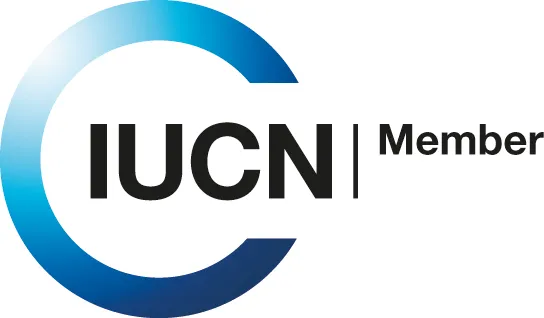

IUCN
IUCN is a membership Union uniquely composed of both government and civil society organisations. It provides public, private, and non-governmental organisations with the knowledge and tools that enable human progress, economic development, and nature conservation to take place together.
Created in 1948, IUCN is now the world’s largest and most diverse environmental network, harnessing the knowledge, resources and reach of more than 1,400 Member organisations and around 15,000 experts. It is a leading provider of conservation data, assessments, and analysis. Its broad membership enables IUCN to fill the role of incubator and trusted repository of best practices, tools, and international standards.
IUCN provides a neutral space in which diverse stakeholders including governments, NGOs, scientists, businesses, local communities, indigenous peoples’ organisations, and others can work together to forge and implement solutions to environmental challenges and achieve sustainable development.
Working with many partners and supporters, IUCN implements a large and diverse portfolio of conservation projects worldwide. Combining the latest science with the traditional knowledge of local communities, these projects work to reverse habitat loss, restore ecosystems, and improve people’s well-being.

Get Involved
Our Mission as a network is to provide practical tools to conserve nature and benefit people, linking local actions with global sustainability targets.
We welcome the participation of organisations that share our vision and mission to protect and enhance High ConservationValues and the vital services they provide for people and nature. By collaborating with the Network, your organisation can contribute to safeguarding HCVs while gaining valuable insights and connections that support your sustainability goals.
We are seeking collaborative partners to help expand and enhance our work, as well as talented professionals who can join the growing Secretariat team, and for professionals who can contribute to the credible identification of High Conservation Values globally.
Join us in securing the world’s HCVs and shaping a sustainable future.
